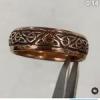It's actually a powder coated RTIC but I can't seem to get rid of the split lines. It's tapered so it has a changing diameter so I'm not sure which rotary parameter to use. I've tried RotaryMark and SplitMark2. I've tried changing the diameter and it's gotten a little better but it's still not good enough. I would have posted a picture, but I just painted the cup to try again. I've gone down to a 2mm split and that doesn't seem to make any difference either. Been following this post http://www.sawmillcreek.org/showthre...ght=cruel+joke but I can't find anything else.





 Reply With Quote
Reply With Quote

 (I found nary a switch inside my machine when I had it apart)
(I found nary a switch inside my machine when I had it apart)
 - fiber lasers
- fiber lasers



